Bird
WARNING: Do not cite this page as a reference. This page is on this wikispace only to make the content "searchable" and easier to find. If you find the information you seek here, go to the original sources to verify the information and use them for your documentation.
Other Bird articles:
Examples:
Period sources:
Cock's comb, two-headed chicken:
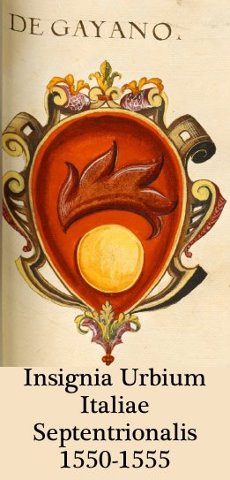
|

|
| BSB Codex 290, f200r, Stemmario Trivulziano shows the same arms of de Gaiano, "Di rosso, alla rotella d'oro sormontata da una cresta di gallo al naturale," or "Gules, a roundel Or surmounted by a cock's crest proper." | Zurich Roll, c1340, two-headed chicken, FB Image courtesy of Oddr Thialfason. |
Crane, two-headed crane, stork:
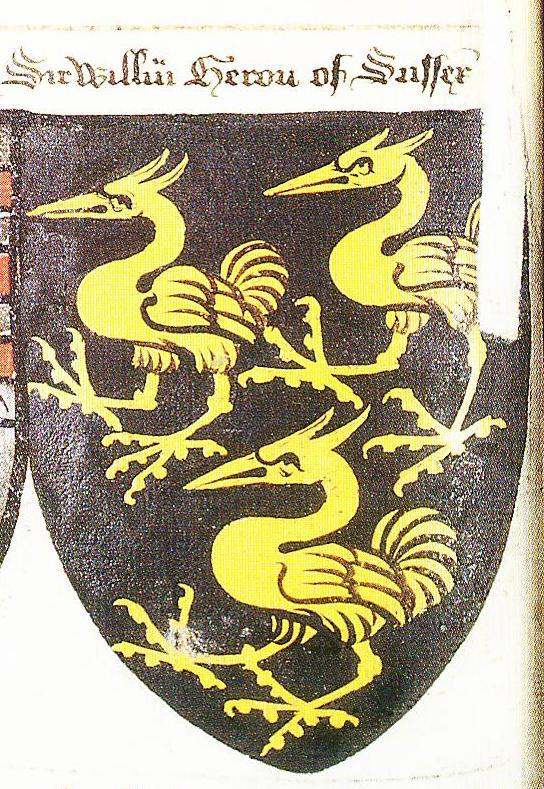
|
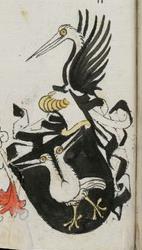
|
|
| Writhe's Book, c.1480, as exerpted in Peter Gwynn-Jones, "The Art of Heraldry", p.35. Sir William Heron of Sussex - Herons | St. Gall Abott Ulrich Rosch Book of Heraldry, 15th cent, two-headed crane. | Zacharias Bartsch, 1567, crane or stork |
Bearded-head chicken monster:
BSB Cgm 145, Das Wappenbuch Conrads von Grünenberg, 1480, folio 212, chicken-head
Eagles:
| Zacharias Bartsch, 1567, eagle and demi-goat | Zacharias Bartsch, 1567, sickles and eagle displayed with mount |
Falcon/hawk, falcon/mockingbird/eagle?
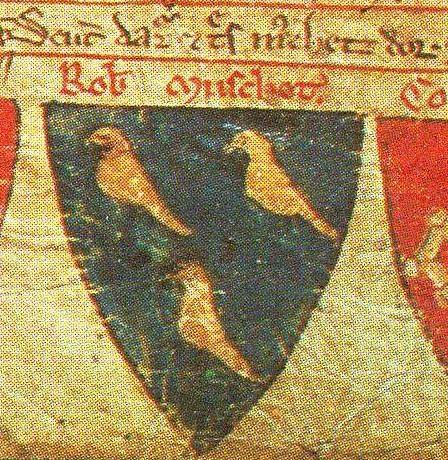
|
||
| Matthew Paris, mid-13th century, falcons or hawks, courtesy of Bruce Draconarius | Zacharias Bartsch, 1567, der Rindtscheidt, possible noneagle displayed | BSB 312, Scheibler, 1450-1580, die Rindscheit, different version of the possible noneagle displayed |
Kingfisher?
Zacharias Bartsch, 1567, kingfisher?
Pelicans:

|

|
| Detail of embroidery from the Pienza Cope. England, second quarter of the 14th century. Pelican. | Marble arch, probably from the former church of Saint-Cosmus, Narbonne, France, second half of twelfth century. |
| Images found via The Medieval Pelican http://donna.hrynkiw.net/sca/pelican/ (collected by Elizabeth Braidwood) |

|
| Aberdeen Bestiary, f35r, c. 1200, pelican attacked by its young, killing them, then resurrecting them with the blood from its breast. |
Ostrich:
Zacharias Bartsche, 1567, ostrich
Owl, dove:
| Zacharias | 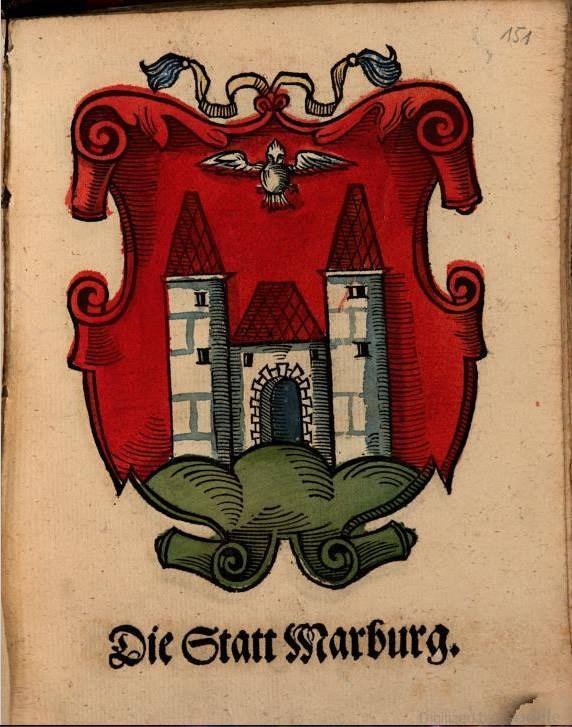
|
| Zacharias Bartsch, 1567, f38r, demi-owl displayed, pink? | Zacharias Bartsch, 1567, f151r, gate/castle, dove displayed |
Parrot/poppinjay:
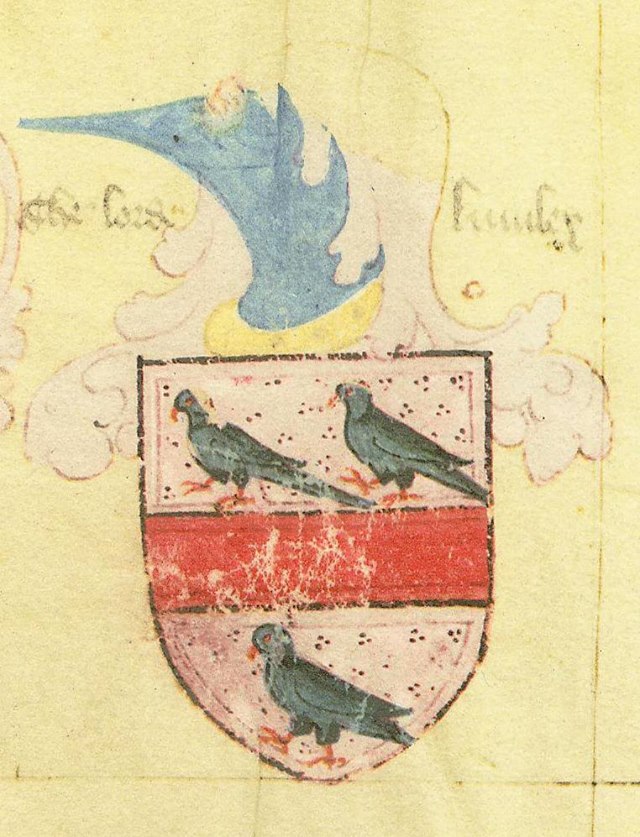
|
| Ballard's Book (William Ballard Exeter Herald) c. 1485, arms of Lumley, poppinjays, sparks as diapering. FB image courtesy of Bruce Draconarius via the 1936 Heralds' Commemorative Exhibition Catalog. |
Vultures:
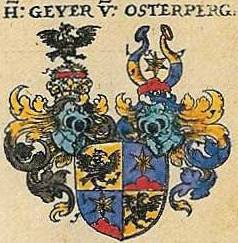
|
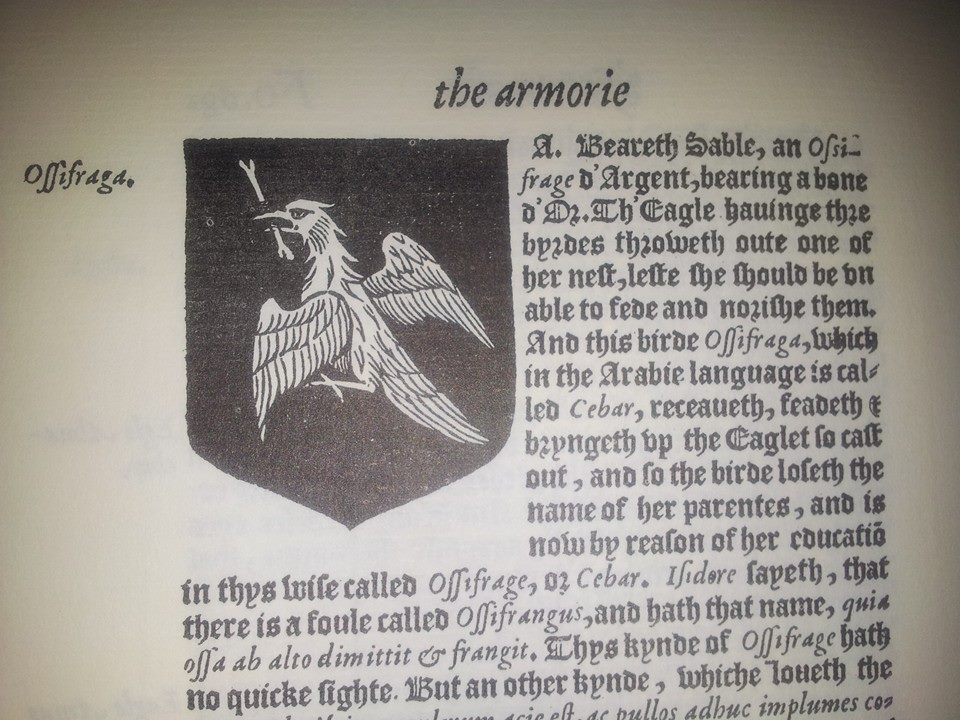
|
| Siebmacher, 1605, plate 34, Geyer family, vultures, mullets, gules mount on azure field | Bossewell Treatise, 1572, ossifrage/vulture |
Modern:
Pictorial Dictionary, 3rd edition:
[http//mistholme.com/dictionary/cock/ cock], crane, crow, dove, eagle, falcon, firebird, goose, hummingbird, martlet, moorcock, ostrich, owl, peacock, pelican, penguin, popinjay, roc, sea-mew, simurgh,swallow, swan, turkeycock, vulture
>
Vector Graphics:
- Viking Answer Lady -[[1]]
Pennsic Traceable Art Project
- [(in its vigilance)]
- [(volant)]
- [(displayed) - page 1]
- [(displayed) - page 2]
- [(volant) - page 1]
- [(volant) - page 2]
- [(naiant)]
- etc.
Sources:
Academy of St. Gabriel "Medieval Heraldry Archive" - [[2]] Archive of St. Gabriel reports - [[3]] Laurel Armory Articles - [[4]] Period Armorials
A Heraldic Primer:
Avians and their postures Just as there are beasts of the field, there are birds of the air. Though not as numerous as the beasts, there are still many different types of birds. One of the primary differences between beasts and birds is that the latter are commonly linked quite closely with a specific posture in period armory. Thus, in period armory, almost all displayed birds are eagles, only storks have the posture 'in their vigilance', only peacocks are 'in their pride' and only pelicans are 'in their piety'. The present Laurel thought on this is that birds who are represented in their period posture, displaying defining characteristics (more on this later) and were considered different in period will generally be considered different (i.e. worth a CD). [See precedents below for more up-to-date info.]
| An eagle | A falcon | An owl |
| [[5]] | [[6]] | http:www.sofyalarus.info/heraldicart/HeraldicPrimer/owl.gif |
| The first group is that of the raptors: Chief among them is the Eagle, being the king of the air, much like the lion is the king of beasts. The eagle is normally seen displayed. Next is the falcon, which is seen as both rising and close in period armory. Finally, there is the owl which is [almost] always seen in period in the close guardant posture. | ||
| Crow | Duck | Dove |
| File:Http://www.sofyalarus.info/heraldicart/HeraldicPrimer/crow.gif | ||
| [[7]] | [[8]] | |
| The next group is the general 'bird' group. The default posture for these is close and include birds such as the crow, duck and dove. | ||
| Crane in his vigilance | Peacock in his pride | Pelican in his piety |
| [[9]] | ||
| [[10]] | ||
| [[11]] | ||
| The final category is reserved for special birds who have postures which make them unique enough to render them different from other birds. These include the crane, peacock and the pelican. [but see Precedent, below] |
Avian Postures
See Bird Postures
Wing postures See Wing. http://heraldry.sca.org/armory/bird-postures.html
In Precedents:
Precedents of the SCA College of Arms - [[12]] Morsulus Heralds Website - [[13]] (to search the LoARs and Precedents) Restatement Wiki - [[14]] (restatements of Precedents) Use the above links to be sure any precedents listed below haven't been superseded by newer precedents.
Definition:
April 2014 - kingfisher has no defined "proper"
#136Tailltiu ghoirt ruaidh. Device. Per fess engrailed Or and azure, in pale a kingfisher proper volant grasping a salmon in annulo argent. This device is returned for using a not easily determined, or defined, proper charge. SENA A3B1 states that "In general, charges that do not have a heraldically defined proper may be described as proper when a normal person would be able to color them appropriately from knowing only the sort of item with no further color description. So, a tree, a thistle, and an elephant can be proper. On the other hand, a female American kestrel, an Arctic fox in winter phase, or a bay horse cannot be proper." A kingfisher's coloration is too complicated to be proper, and so a kingfisher proper is not registerable. http://heraldry.sca.org/loar/2014/04/14-04lar.html#136
August 2012 - generic birds are regular-shaped:
This month we explicitly ruled that generic birds fit into the "regular-shaped" bird category as set forth on the November 2003 Cover Letter. [[15]]
March 2012 - penguin-shaped birds:
...when considering the categories of birds set forth on the November 2003 Cover Letter [see below], we have decided that penguin-shaped birds, by which we mean penguins and auks, when depicted in their default upright close posture are substantially different from all other birds. The use of a penguin is still a step from period practice. [[16]]
February 2007 - flamingos proper:
In April 1985 (q.v., Cherie Ruadh MhicRath of Locksley) Laurel ruled, "The color of a flamingo's feathers is apparently dependent on its diet, so there really is no 'proper' color." This has been interpreted to mean that flamingos proper could not be registered; however, pink flamingos proper have been registered since that time, including as recently as April 2006. The 1985 precedent is hereby overturned; a pink flamingo proper is registerable. It is dark pink while the tincture of its beak and legs are treated as artistic license. Its tincture is a color, not a metal. [2007 LoAR]
January 2007 - Old World vs New World vultures:
#66Thomas DeGuy Bassard. Badge. (Fieldless) In pale a vulture close sable perched on a covered tankard azure charged with a compass star of sixteen points argent. ... Please advise the submitter that having a vulture in his badge doesn't cant on his name as in period Europe, buzzard// didn't refer to a vulture, but to the //Buteo// genus of hawks: "An inferior kind of hawk, useless for falconry," according to the OED. Applying the term //buzzard// to a vulture seems to be a uniquely New World practice. We note that //European vultures are perfectly acceptable as heraldic charges. But they weren't depicted with featherless heads, as here: featherless heads distinguish New World vultures. http://heraldry.sca.org/loar/2007/01/07-01lar.html
October 2003 - Generic Birds
In the last months we have often received commentary suggesting that some charge should be reblazoned from a specific sort of bird to a generic bird (e.g., reblazoning a hawk// as //a bird). We remind the College that we should only reblazon a specific sort of bird as a generic bird when the specific bird truly cannot be identified as such. We also remind the College that the reblazon to a generic bird has unfortunate side effects for conflict. As noted on the LoAR of April 1998, "Blazoned on the LoI as [a specific type of bird], as drawn it is not clearly any species of bird, so we have reblazoned it as a generic bird. Unfortunately, generic birds conflict with all birds, so this conflicts with ..." When one proposes to reblazon an imperfectly-drawn "hawk" as a generic "bird", it would lose an often-critical type CD from past or future submissions using swans, herons, chickens, peacocks, ostriches, hummingbirds, penguins, and so forth. Never forget that the suggestion to reblazon a specific bird as a generic bird is also a proposal to reward a poor artist with an unwontedly huge slice of armorial space. When we reflect on the quality of much period heraldic artwork, which is rarely precise in its depiction of birds or other animals, I think we can all agree that birds should only be reblazoned as "generic" birds when there is no other alternative. We have also continued to receive commentary indicating that ravens that are not drawn as "hairy" birds should be reblazoned as generic birds. This suggestion does not match period armorial style, which often depicts ravens as smooth-feathered birds. Please refer to the cover letter to the January 2002 LoAR, which discusses this matter in detail, including citations in commonly-available heraldry books showing specific examples of smooth-feathered/non-hairy corbies in period heraldic art. [[17]]
September 2002 - brown sparrows proper:
#G_ANSTEORRA_24Líadan Arundel. Device. Argent, a chevron gules between three brown sparrows close proper. > It is only acceptable to blazon an animal as a brown animal proper when that animal is frequently found in a brown color in nature, as per the Cover Letter of October 1995, which states in pertinent part in part "... animals which are normally brown may be registered simply as an {X} proper (e.g., boar proper, hare proper). Animals which are frequently found as brown but also commonly appear in other tinctures in the natural world may be registered as a brown {X} proper (e.g., brown hound proper, brown horse proper)" > Period Western European sparrows are not brown birds, but distinctly marked birds. The male is about one-third brown with the remainder marked in black and white. The less distinctive female is half brown and half off-white. One typical species is Passer domesticus, which is called the house sparrow in both Europe and the United States. It is thus appropriate to inquire as to how a bird with such natural markings would be depicted in period heraldry when proper. Documentation was neither provided nor found for sparrows proper in period armory, so we have to draw conclusions based on other similarly marked proper birds. > There is evidence that birds that are black and white in nature are depicted as black and white birds when proper, even if their markings in the heraldic depictions are not quite correct for the species. The black and white stork with red legs and beak in the arms of Die Dobrzinsky on f. 73 of Siebmacher (from Silesia) is depicted very much like a European stork. There are two types of European stork, the White Stork and the Black Stork. Both are black and white birds with red beak and legs. Siebmacher's depiction is closer to a White Stork. Rietstap's blazon for this family indicates that the bird there depicted is intended to be a stork proper (beaked and membered gules, although this would, as stated, also be proper for a stork). Siebmacher also gives us the arms of von Atzelndorf (from Meissen) on f. 156 using a black and white bird. Atzel is the German word for magpie, and a magpie is a black and white bird, so it seems logical to conclude that the bird in these arms is meant to be a magpie. The Siebmacher rendition does not do a good job of duplicating a magpie's natural markings, but its proportions and general black and white coloration are correct for a magpie. A more accurately marked magpie proper may be found in the 15th C Milanese Stemmaria Trivulziano, p. 67, in the arms of de Bertis. The magpie there is black and white and the markings mostly follow the natural markings of a magpie. The editors inform us that the word berta means magpie (although it is not the most common Italian word for that bird) and de Bertis thus has canting arms. > Because birds that are black and white in nature appear to be drawn black and white when proper in period heraldry, it is not reasonable to assume that the partially brown and partially black and white sparrow would be solid brown in period heraldry. The female sparrow is a closer match, but is still not an "all brown bird". Also, as a general rule, it is the more colorful member of a species that is used to determine the proper coloration of a species in heraldry, the peacock being the prime example of this practice. Thus, unless evidence is provided for brown sparrows proper in period armory, they may not be registered in the SCA. > Note that some New World birds that are called "sparrows" in modern terminology are mostly brown in their coloration, unlike the Old World species. It does not seem appropriate to consider species outside of Western Europe when considering the proper tincture of an animal, unless the animal being considered is a distinctly non-European animal, such as the turkey (which is found in its proper coloration as the crest of Robert Cooke in 1556). > http://heraldry.sca.org/loar/2002/09/02-09lar.html
February 2002 - bird passant:
"A bird passant, that is to say, with one leg raised, is considered an unblazoned variant of close" February 1996 LoAR & [February 2002 LoAR
Registerability:
(Restricted, Reserved, SFPP, OOP)
September 2020 - non-eagles displayed:
From Wreath: On Birds Displayed This month provides another opportunity to continue our fascinating journey revisiting old steps from period practice. This month Iago Coquille asks us to reconsider whether it is appropriate to impose a step from period practice for the use of birds displayed, where the bird is not an eagle. . . we remove the step from period practice. http://heraldry.sca.org/loar/2020/09/20-09cl.html
November 2012 - non-eagles displayed:
From Wreath: Blazoning Fun -- Non-Eagles Displayed We have long held that the use of any bird other than an eagle in the displayed posture is a step from period practice... http://heraldry.sca.org/loar/2012/11/12-11cl.html
February 2007 - pink flamingos proper:
In April 1985 (q.v., Cherie Ruadh MhicRath of Locksley) Laurel ruled, "The color of a flamingo's feathers is apparently dependent on its diet, so there really is no 'proper' color." This has been interpreted to mean that flamingos proper could not be registered; however, pink flamingos proper have been registered since that time, including as recently as April 2006. The 1985 precedent is hereby overturned; a pink flamingo proper is registerable. It is dark pink while the tincture of its beak and legs are treated as artistic license. Its tincture is a color, not a metal. [2007 LoAR]
January 2007 - Old World vs New World vultures:
#66Thomas DeGuy Bassard. Badge. (Fieldless) In pale a vulture close sable perched on a covered tankard azure charged with a compass star of sixteen points argent. This badge is returned for being two steps from period practice. The first is for the use of a compass star (which is an SCA-compatible charge). The second is for using a New World bird that is not found in period heraldry heraldry - this bird is clearly a variant of the American birds named "vultures" rather than the unrelated European birds named vultures. ...We note that European vultures are perfectly acceptable as heraldic charges. But they weren't depicted with featherless heads, as here: featherless heads distinguish New World vultures. http://heraldry.sca.org/loar/2007/01/07-01lar.html
November 2006 - Turkeys:
"Consider a turkey and a manatee: they are both New World fauna, but the turkey is documented as part of a crest in period armory. The use of a turkey, therefore, is not a SFPP." http://heraldry.sca.org/loar/2006/11/06-11cl.html
Conflict:
March 2014 - barnacle goose tree vs other trees:
#183ffride wlffsdotter. Badge. (Fieldless) A barnacle goose tree gules fructed Or. Blazoned on the Letter of Intent as a barnacle goose, this submission is actually of the barnacle goose plant or tree, not just the bird itself. The period citations of this bird all do show birds growing from a tree or plant, but the depiction of the tree or plant varies widely, and is not the focus of the citations. This then appears to be a tree with birds, either as fructing on the tree or as effectively maintained charges. This badge is therefore returned for conflict with the badge of Walraven van Nijmegen, (Fieldless) A créquier gules. There is a DC for fieldlessness, but nothing for the fructing of or maintained barnacle geese. [[18]]
November 2012 - non-eagles displayed:
From Wreath: Blazoning Fun -- Non-Eagles Displayed ...The January 2000 Cover Letter stated that "with vanishingly rare exceptions the eagle is the only bird found displayed in period heraldry. Therefore any other bird displayed will arguably be visually similar to an eagle..." This visual similarity affects how much difference we can grant when considering conflict between a non-eagle displayed and an eagle displayed. In the case of a _raven displayed_, a fairly popular charge lately, versus an _eagle displayed_, there is neither a substantial nor a distinct change.
There is, however, a blazonable difference between a non-eagle displayed and an eagle displayed... http://heraldry.sca.org/loar/2012/11/12-11cl.html
January 2009 - kingfisher as regular-shaped bird vs. goose:
#3Althaia filia Lazari. Device. Azure, a kingfisher rising argent within a torse wreathed argent and sable. This device is clear of Rorik Fredericsson, Azure, a grey goose volant bendwise wings addorsed proper gorged of a coronet Or. Based on the November 2003 Cover Letter ruling on birds and substantial difference, the kingfisher falls in the "regular-shaped birds" category and geese fall within the "swan-shaped birds" category. Since there is substantial difference between these bird types, these devices are clear by X.2. If we count CDs, there is one of the change of type of bird and another for the addition of the torse. http://heraldry.sca.org/loar/2009/01/09-01lar.html
August 2007 and January 2002 - falcon v chough, falcon v raven:
"There is no difference between the falcon and the Cornish chough."January 2002 LoAR BUT...""Normally a detail as small as a beak would not be grounds for a CD; however, RfS X.4.e states in part "Types of charges considered to be separate in period, for example a lion and an heraldic tyger, will be considered different." As a merlin/falcon close and a raven close are both period heraldic charges, in their period posture (close), and as period heralds consistently distinguished, in their heraldic art, the birds in these positions, we will grant a CD between a merlin/falcon close and a raven close."[2007 LoAR Cover Letter]
May 2007 - magpie vs vulture or raven:
#207Marguerite de Saint Nazaire. Badge. (Fieldless) A magpie proper. This badge also conflicts with... In each case there is a CD for fieldlessness but no difference is granted between a magpie and a raven. Nor is there a CD for location of the ravens when compared to a fieldless badge. A magpie can have varying amounts of white; some depictions of a magpie proper// are primarily sable. Given this, there is not a CD for tincture between a //magpie proper// and a //magpie sable. Concerning the device for Serlo of Litchfield, Gyronny gules and Or, a vulture close sable//, there is a CD for fieldlessness, but nothing for tincture of the bird. The question thus becomes whether or not a magpie conflicts with a vulture. There are prior precedents stating that a vulture conflicts with a hawk. There is no difference granted between a hawk and a raven, nor between a raven and a magpie. However, conflict is not necessarily transitive and a vulture may not conflict with a magpie. If this is resubmitted, we recommend that the submitter (and the East CoH) be prepared to show that a CD //should be granted between a magpie and a vulture. http://heraldry.sca.org/loar/2007/05/07-05lar.html
December 2006 - American v English/European robin:
No difference is granted between an American or English/European robin. Both types of robin are brown with red breast; the underbelly is white for an English/European robin and red for an American robin. A robin may be blazoned as proper no matter where it is from - the tincture of the underbelly is artistic license. This robin has an argent underbelly; it is a European robin. December 2006 LoAR
November 2003 - Birds and Substantial Difference
This month we were called upon to make a number of rulings concerning difference between very different types of birds. After much thought, and discussion with Evan Wreath-designate, we have formulated the following policy.
- Policies concerning birds and substantial difference need to be built upon previous policies concerning birds and significant difference. An important ruling on the topic is found in the Cover Letter for the January 2000 LoAR. That ruling was entitled On Owls and Eagles, but it also spoke more generally concerning difference for birds. The pertinent summary portions of that ruling read as follows:
- The conflict rules make a rigid distinction between the type of a charge and its posture. This works well most of the time, but less so for birds, where the type and the posture are often closely connected. In particular, with vanishingly rare exceptions the eagle is the only bird found displayed in period heraldry. Therefore any other bird displayed will arguably be visually similar to an eagle...
- The new solution to the problem is to sacrifice some of the theoretical purity of separation of type and posture. Because only eagles among birds are attested as displayed in period, any other bird in a displayed posture will be compared to any bird in a displayed posture usuing [sic] the visual test of rule X.4.e for non-period charges. Thus there will not be a CD between an owl displayed and an eagle displayed, because they are too visually similar, but there will be a CD between an owl displayed and a penguin displayed, because there is still significant visual difference. Additionally any bird other than an eagle in a displayed posture will be considered a "weirdness" [step from standard period practice].
- In the future I expect that I will be more likely to grant difference between different types of birds when (a) [sic] they are (a) different in period, (b) in a period posture, (c) drawn correctly, and (d) there is some visual difference (i.e., there is really no visual difference between a popinjay and a hawk).
- In some cases, it is appropriate for very different types of bird to be given substantial difference from each other. This parallels the SCA's precedents for other kinds of similarly-formed, but nonetheless very different, animate charges: bulls and lions were ruled substantially different in the LoAR of July 2001, dragons and griffins were ruled substantially different in the same LoAR, zebras and stags were ruled substantially different in the LoAR of May 2001, unicorns and wolves were ruled substantially different in the LoAR of March 1994, and ferrets and hedgehogs were ruled substantially different in the LoAR of September 1991.
- In order for two birds to be considered substantially different from each other, it is necessary for the following conditions to apply, analogous to the criteria listed in the January 2000 Cover Letter for significant difference between birds:
- The change from one type of bird to the other type of bird must "not usually [have been] used to indicate any form of cadency" in period (RfS X.2). The two types of bird must of course also have been considered different in period, or they would not even be significantly different (RfS X.4.e).
- Each bird, in both the new and the old submissions, must be in a posture which was period for that type of bird.
- Each bird, in both the new and the old submissions, must be drawn correctly.
- The two types of bird must have been drawn in fashions that were consistently very different from each other throughout period heraldry.
Concerning criterion 2, remember that a bird may be in a period posture without being in a default posture. Ravens are sometimes found in the rising posture in period, although their default posture is close. Swans are found in the close posture in period, although their default posture is rousant (synonymous with rising). It is vanishingly rare to find birds other than eagles in the displayed posture, while vast multitudes of eagles are found in the displayed posture. We thus re-affirm the January 2000 Cover Letter precedent (above). All birds (other than eagles) in the displayed posture are considered a "weirdness" and are not eligible for substantial difference - unless documentation is provided showing that the particular type of (non-eagle) bird is frequently found in the displayed posture in period. Here are a few generalizations concerning bird posture to be used in conjunction with criterion 2 above. In addition, see the attachment to this LoAR titled "Some birds and the postures in which they are found in period English heraldry."
- Barring evidence to the contrary for a particular type of bird, it may be assumed that any type of bird is in a period posture when it is close.
- If a bird is found in a rising posture in period, it is reasonable to assume that both rising wings addorsed and rising wings displayed are standard variants of that posture.
- Period birds that are reguardant are considered a standard posture variant of period birds that are not reguardant. So, if a bird is found in the rising posture in period, it is reasonable to assume that rising reguardant is also a period posture. One cannot make the same assumption about guardant.
- Turning any type of bird to sinister is considered a standard posture variant for all period heraldic postures, due to long-standing SCA practice. So, if a bird is found in the naiant posture in period, then for purposes of SCA heraldic rulings we will also consider the naiant to sinister posture to be period.
- On examining the types of birds found in period armory, and how they were used, certain categories of bird type become apparent. These categories are:
- Swan-shaped birds, including swans, geese, and ducks: waterfowl with long necks, rounded bills, long heavy bodies, webbed feet.
- Crane-shaped birds, including cranes, herons, and storks: tall thin birds with long necks, long pointed beaks, medium-weight bodies, very long legs.
- Poultry-shaped birds, including chickens, quail, partridge, and peacocks: compact rounded birds with short to medium necks, short beaks, heavy rounded bodies, medium or short legs, often with distinctive tails or head details (combs, crests).
- Regular-shaped" birds, including martlets, ravens and other corbies, raptors (hawks, eagles, and owls), and doves: birds with the classic "bird shape". Compact light- or medium-weight birds with small necks and beaks, short to medium legs, plain tails.
Not all period birds are found in the categories above. For example, while many popinjays (parrots) are drawn as "regular-shaped" birds in period (often indistinct from a green crow with red legs and bill), some of the more naturalistic drawings of popinjays have such pronounced tails that popinjays, for the moment, been left out of any of these categories. Substantial difference relates to these categories of birds as follows:
- Birds within a category are not substantially different [SC] from each other. They may be (but are not always) significantly different [DC] from each other based on the criteria in RfS Part X, Conflicting Armory (RfS X.4.e). Within the "regular-shaped birds" category, there is significant difference [DC] between an owl (close guardant) and a dove (close), but not substantial difference [SC]. However, in the same category, there is no difference between a falcon rising and an eagle rising.
- Birds in different categories are given substantial difference [SC] from each other as long as they meet the general requirements for substantial difference listed above. Thus, a correctly drawn dunghill cock (close), in the "poultry-shaped" bird category, is substantially different from a "crane-shaped" heron (close), a "swan-shaped" swan close, or a "regular-shaped" martlet (close). However, a "poultry-shaped" dunghill cock volant is not substantially different [SC] from a "regular-shaped" dove volant, because, while the dove is found in the volant posture in period heraldry, the dunghill cock is not.
- Birds that are not mentioned as part of the categories above must have their eligibility for substantial difference [SC] determined on a case by case basis. In particular, SCA-compatible birds that are not found in period heraldry, such as some New World birds, may be considered in a category with very similar Old World birds, on a case by case basis.
http://heraldry.sca.org/loar/2003/11/03-11cl.html
March 2003 - head position:
"There is no difference in posture between these birds except for the head position, which is insufficient for posture difference by RfS X.4.h." March 2003 LoAR
May 2002 - single- vs. double-headed eagle, contourny
Egil Haraldsson. Device. Vert, an eagle Or. Conflict with Constantinople, Emperor of, Gules, a double-headed eagle Or. There is one CD for changing the field, but nothing for changing the type of eagle from a double-headed to a single-headed eagle. This also conflicts with Napoleon I, Azure, an eagle displayed contourny grasping in both claws a thunderbolt Or. There is one CD for changing the field but nothing for changing the head posture only of the eagle and nothing for removing the small held thunderbolt. There are other conflicts as well, but none so illustrious. [19]
February 2002 - passant v close:
"A bird passant, that is to say, with one leg raised, is considered an unblazoned variant of close" February 1996 LoAR & February 2002 LoAR
June 1995 - parrot vs falcon
Aleksandr the Traveller. Badge. [Fieldless] A parrot close argent, tailed gules. As drawn, this conflicts with Tangwystyl verch Morgant Glasvryn (SCA), Per chevron argent and vert, in base a falcon close argent... Though X.4.e. would normally grant a CD for difference between charges considered different in period, the bird here is drawn so that it appears to be more falcon-like than parrot-like, making this a visual conflict. http://heraldry.sca.org/loar/1995/06/lar.html
September 1989 - cardinal vs. the world:
Dennis Landhammer. Device. Or, a cardinal close proper. Since the cardinal is red with some minor black markings on the face and only a single major can be derived for difference of type of bird, this is in conflict with several coats which feature red birds on an Or field: Fysher ("Or, a kingfisher close gules.", cited in Papworth, p. 305), Aquila ("Or, an eagle close gules." ibid., p. 301) and Cheeke ("Or, a cock gules, beaked sable.", ibid., p. 295). [Note: This decision dates from a time when SCA devices were conflict checked against all mundane heraldry unlike the current practice of only protected important mundane arms and differences were figured differently. Also note that under the 2003 Cover Letter, a cardinal "regular shaped" would certainly not conflict with a cock "poultry shaped".] http://heraldry.sca.org/loar/1989/09/lar.html
Identifiability:
November 2012 - non-eagles displayed:
From Wreath: Blazoning Fun -- Non-Eagles Displayed We have long held that the use of any bird other than an eagle in the displayed posture is a step from period practice. The January 2000 Cover Letter stated that "with vanishingly rare exceptions the eagle is the only bird found displayed in period heraldry... The blazon must be able to accurately describe the submitted emblazon. If we cannot tell from the submitted emblazon that a displayed bird is not an eagle, it will be reblazoned as an eagle... http://heraldry.sca.org/loar/2012/11/12-11cl.html
Collected Precedents:
2nd Tenure of Elisabeth de Rossignol (April 2011 - August 2011) -
- BIRD - Cock and Hen
- BIRD - Crane-shaped
- BIRD - Duck see BIRD - Swan-shaped
- BIRD - Falcon
- BIRD - Hen see BIRD - Cock and Hen
- BIRD - Heron see BIRD - Crane-shaped
- BIRD - Hummingbird see BIRD - Miscellaneous
- BIRD - Owl
- BIRD - Peacock
- BIRD - Penguin see BIRD - Miscellaneous
- BIRD - Raven
- BIRD - Simurgh see BIRD - Peacock
- BIRD - Swan see BIRD - Swan-shaped
- BIRD - Swan-shaped
- BIRD - Wren see [BIRD - Miscellaneous
1st Tenure of Elisabeth de Rossignol (May 2005 - July 2008) -
- BIRD - Bird of Paradise see BIRD - Miscellaneous
- BIRD - Chimney Swift
- [BIRD - Cock and Hen
- BIRD - Cockatoo
- BIRD - Corbie see BIRD - Raven
- BIRD - Crane-shaped
- http://heraldry.sca.org/precedents/elisabeth/armory.html#BIRDCrow BIRD - Crow]
- BIRD - Dodo see [BIRD - Miscellaneous
- BIRD - Dove
- BIRD - Duck see BIRD - Swan-shaped
- BIRD - Dunghill Cock see BIRD - Cock and Hen
- BIRD - Eagle
- BIRD - Falcon and Hawk
- BIRD - Flamingo see BIRD - Crane-shaped
- BIRD - Generic
- BIRD - Goose see BIRD - Swan-shaped
- BIRD - Hawk see BIRD - Falcon and Hawk
- BIRD - Hen see BIRD - Cock and Hen
- BIRD - Hummingbird see BIRD - Miscellaneous
- BIRD - Magpie see BIRD - Raven
- BIRD - Martlet
- BIRD - Merlin see BIRD - Falcon and Hawk
- BIRD - Miscellaneous
- BIRD - Owl
- BIRD - Peacock
- BIRD - Penguin see BIRD - Miscellaneous
- BIRD - Popinjay
- BIRD - Raven
- BIRD - Robin see [BIRD - Miscellaneous
- BIRD - Rooster see BIRD - Cock and Hen
- BIRD - Russian Firebird see BIRD - Peacock
- BIRD - Sandpiper see BIRD - Miscellaneous
- BIRD - Simurgh see BIRD - Peacock
- BIRD - Snipe see BIRD - Miscellaneous
- BIRD - Swallow see BIRD - Miscellaneous
- BIRD - Swan see BIRD - Swan-shaped]
- BIRD - Swan-shaped
- BIRD - Vulture
The 2nd Tenure of François la Flamme (October 2004 - May 2005) -
- BIRD -- Cock and Hen],
- BIRD -- Corbie see //[BIRD -- Raven
- BIRD -- Eagle],
- BIRD -- Falcon and Hawk,
- BIRD -- Generic,
- BIRD -- Miscellaneous,
- BIRD -- Peacock],
- BIRD -- Raven],
- BIRD -- Swan]
The Tenure of Shauna of Carrick Point (May 2004 - August 2004) -
The Tenure of François la Flamme (August 2001 - April 2004) -
- BIRD -- Cock and Hen]
- BIRD -- Corbie see [BIRD -- Raven]
- BIRD -- Cornish Chough]
- BIRD -- Dove]
- BIRD -- Duck]
- BIRD -- Eagle]
- BIRD -- Falcon and Hawk]
- BIRD -- Generic]
- BIRD -- Goose]
- BIRD -- Loon]
- BIRD -- Martlet]
- BIRD -- Miscellaneous
- BIRD -- Owl]
- BIRD -- Peacock
- BIRD -- Quail
- BIRD -- Raven
- BIRD -- Ravens and Similar Birds
- BIRD -- Sparrow
- BIRD -- Swan
- BIRD -- Vulture
- BIRDS and SUBSTANTIAL DIFFERENCE see also [http:heraldry.sca.org/precedents/francois/wreath.html#AppendixA APPENDIX A -- Some birds and the postures in which they are found in period English heraldry]
The Tenure of Elsbeth Anne Roth (June 1999 - July 2001) -
- BIRD -- Chicken,
- BIRD -- Eagle,
- <BIRD -- Falcon,
- BIRD -- Hawk,
- BIRD -- Owl,
- BIRD -- Precedent on Difference,
- BIRD -- Raven,
- BIRD -- Swan
The Tenure of Jaelle of Armida (June 1996 - June 1999) - Bird] The 2nd Tenure of Da'ud ibn Auda (November 1993 - June 1996) -
- <the 1st part] (Nov 1993 - June 1994) - Bird]
- the 2nd part (July 1994 - June 1996) - Bird
The Tenure of Bruce Draconarius of Mistholme (June 1992 - October 1993) -
- BIRD -- Chicken,
- BIRD -- Crow,
- BIRD -- Dodo,
- BIRD -- Dove,
- BIRD -- Duck, Goose, or Swan,
- BIRD -- Eagle and Falcon,
- BIRD -- Hummingbird,
- BIRD -- Misc,
- BIRD -- Owl,
- BIRD -- Parrot and Popinjay.
- BIRD -- Peacock,
- BIRD -- Pheasant,
- BIRD -- Swallow
The 1st Tenure of Da'ud ibn Auda (June 1990 - June 1992) -
- 1st year] (June 1990 - June 1991) - BIRD
- the 2nd year (July 1991 - June 1992) - BIRD
The Tenure of Alisoun MacCoul of Elphane (September 1986 - June 1990) -
The Tenure of Baldwin of Erebor (August 1984 - August 1986) - Single HTML Document The Tenure of Wilhelm von Schlüssel (August 1979 - August 1984) - BIRD The Tenure of Karina of the Far West (December 1975 - June 1979) - BIRD The Early Days (June 1971 - June 1975) - BEAKED, BIRD
In the Ordinary
(includes albatross, alerion, avosetta, blackbird, bluejay, bustard, chicken, chough, cock, cockatoo, corbie, cormorant, crane, crow, curlew, cygnet, dodo, dove, drake, duck, eagle, egret, falcon, finch, flamingo, frigate bird, gamecock, gander, goose, goshawk, gull, gyrfalcon, heathcock, hen, heron, hummingbird, ibis, jay, kestrel, kingbird, kingfisher, kite, linnet, loon, macaw, magpie, martlet, merlin, mew, moorcock, nightinggale, oriole, osprey, ostrich, owl, paraclete, parrot, peacock, pelican, penguin, peregrine, petrel, pheasant, pigeon, plover, popinjay, puffin, quetzal, raven, roadrunner, robin, roc, rooster, sea bird, sea gull, sea mew, seagull, simurgh, skylark, songbird, sparrow, sparrowhawk, starling, stork, swallow, swan, swift, etc.)
- Bird - Demi]
- Bird - Sea - see Bird] and [Monster - Other]
- Bird - Whole - 1 - Bird affronty]
- Bird - Whole - 1 - Close to dexter - Argent]
- Bird - Whole - 1 - Close to dexter - Azure]
- Bird - Whole - 1 - Close to dexter - Fur]
- Bird - Whole - 1 - Close to dexter - Gules]
- Bird - Whole - 1 - Close to dexter - Multicolor]
- Bird - Whole - 1 - Close to dexter - Or]
- Bird - Whole - 1 - Close to dexter - Proper]
- Bird - Whole - 1 - Close to dexter - Purpure]
- Bird - Whole - 1 - Close to dexter - Sable]
- Bird - Whole - 1 - Close to dexter - Vert]
- Bird - Whole - 1 - Close to sinister]
- Bird - Whole - 1 - Displayed - Argent]
- Bird - Whole - 1 - Displayed - Azure]
- Bird - Whole - 1 - Displayed - Fur]
- Bird - Whole - 1 - Displayed - Gules]
- Bird - Whole - 1 - Displayed - Multicolor]
- Bird - Whole - 1 - Displayed - Or]
- Bird - Whole - 1 - Displayed - Proper]
- Bird - Whole - 1 - Displayed - Purpure]
- Bird - Whole - 1 - Displayed - Sable]
- Bird - Whole - 1 - Displayed - Vert]
- Bird - Whole - 1 - Migrant to base]
- Bird - Whole - 1 - Rising to dexter]
- Bird - Whole - 1 - Rising to sinister]
- Bird - Whole - 1 - Stooping to dexter]
- Bird - Whole - 1 - Stooping to sinister]
- Bird - Whole - 1 - Volant to dexter]
- Bird - Whole - 1 - Volant to sinister]
- Bird - Whole - 1 - Other bird posture]
- Bird - Whole - 2 - Argent]
- Bird - Whole - 2 - Azure]
- Bird - Whole - 2 - Fur]
- Bird - Whole - 2 - Gules]
- Bird - Whole - 2 - Multicolor]
- Bird - Whole - 2 - Or]
- Bird - Whole - 2 - Proper]
- Bird - Whole - 2 - Purpure]
- Bird - Whole - 2 - Sable]
- Bird - Whole - 2 - Vert]
- Bird - Whole - 3 or more]
- Bird bolt - see [Arrow]
- Bird of paradise plant - see [Plant - Other]
- Bird's egg - see [Cartouche] and Foodstuff]
- Bird's feather - see [Feather]
- Bird's head - see [Head - Bird]
- Bird's leg - see [Leg - Bird]
- Body part] - (includes coxcomb, toe... ) see also Eye] and [Hand] and Leg] and [Bone] and Head] and [Tooth] and Moustache]